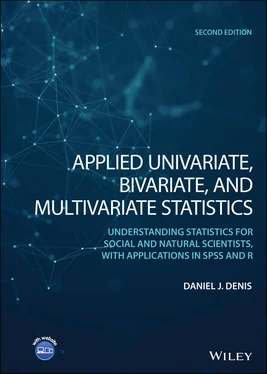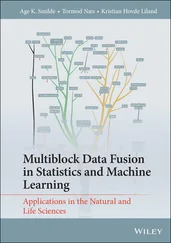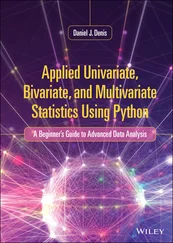The right of Daniel J. Denis to be identified as the author of this work has been asserted in accordance with law.
Registered Office John Wiley & Sons, Inc., 111 River Street, Hoboken, NJ 07030, USA
Editorial Office 111 River Street, Hoboken, NJ 07030, USA
For details of our global editorial offices, customer services, and more information about Wiley products visit us at www.wiley.com.
Wiley also publishes its books in a variety of electronic formats and by print‐on‐demand. Some content that appears in standard print versions of this book may not be available in other formats.
Limit of Liability/Disclaimer of Warranty While the publisher and authors have used their best efforts in preparing this work, they make no representations or warranties with respect to the accuracy or completeness of the contents of this work and specifically disclaim all warranties, including without limitation any implied warranties of merchantability or fitness for a particular purpose. No warranty may be created or extended by sales representatives, written sales materials or promotional statements for this work. The fact that an organization, website, or product is referred to in this work as a citation and/or potential source of further information does not mean that the publisher and authors endorse the information or services the organization, website, or product may provide or recommendations it may make. This work is sold with the understanding that the publisher is not engaged in rendering professional services. The advice and strategies contained herein may not be suitable for your situation. You should consult with a specialist where appropriate. Further, readers should be aware that websites listed in this work may have changed or disappeared between when this work was written and when it is read. Neither the publisher nor authors shall be liable for any loss of profit or any other commercial damages, including but not limited to special, incidental, consequential, or other damages.
Library of Congress Cataloging‐in‐Publication Data applied for: ISBN 978‐1‐119‐58304‐2
Cover Design: Wiley
Cover Image: © tatianazaets/Getty Images
To Kaiser
Technology is not progress. Empathy is. The dogs are watching us .
Now in its second edition, this book provides a general introduction and overview of univariate through to multivariate statistical modeling techniques typically used in the social, behavioral, and related sciences. Students reading this book will come from a variety of fields, including psychology, sociology, education, political science, biology, medicine, economics, business, forestry, nursing, chemistry, law,among others. The book should be of interest to anyone who desires a relatively compact and succinct survey and overview of statistical techniquesuseful for analyzing data in these fields, while also wanting to understand and appreciate some of the theory behind these tools. Spanning several statistical methods, the focus of the book is naturally one of breadththan of depthinto any one particular technique, focusing on the unifying principles as well as what substantively (scientifically) can or cannot be concluded from a method when applied to real data. These are topics usually encountered by upper division undergraduateor beginning graduatestudents in the aforementioned fields.
The first edition has also been used widely as a reference resource for both students and researchers working on dissertations, manuscripts, and other publications. It is hoped to provide the student with a “big picture” overview of how applied statistical modeling works, while at the same time providing him or her the opportunity in many places to implement, to some extent at least, many of these models using SPSS and/or R software. References and recommendations for further reading are provided throughout the text for readers who wish to pursue these topics further. Each topic and software demonstration can literally be “unpacked” into a deeper discussion, and so long as the reader is aware of this, they will appreciate this book for what it is— a bird's eye view of applied statistics, and not the “one and only” source they should refer to when conducting analyses. The book does not pretend to be a complete compendium of each statistical method it discusses, but rather is a survey of each method in hopes of conveying how these methods generally “work,” what technical elements unites virtually all of them, and the benefits and limitations of how they may be used in addressing scientific questions.
This second edition has been revised to make the book clearer and more accessible compared to the first edition. The book also contains a gentle introduction (“foot in the door”) to a variety of new topics that did not appear in the first edition. All chapters have been edited to varying degrees to improve clarity of prose and in places provide more information or clarification of the concept under discussion. The following is a summary of updates and revisions in the second edition:
Significant revision and corrections of errata appearing in the first edition. The second edition is a stronger and better book because it has been thoroughly re‐read and edited in places where rewording was required. In this sense, the second edition has undergone very much “vetting” since the first edition. At the same time, some sections have been entirely deleted from the first edition due to their explanations being too brief to make them worthwhile. These are sections that did not seem to “work” in the first edition, so they were omitted in the second. This hopefully will help improve the “flow” of the book without the reader stumbling across sections that are insufficiently explained.
Bolded text is used quite liberally to indicate emphasis and signal areas that are key for a good understanding of applied statistics. “Accentuate” bold text when reading the book. They are the key words and themes around which the book was built.
The images in many chapters have been reproduced to make them clearer and more detailed than in the first edition. This is thanks to Wiley's team who has reconstructed many of the figures and diagrams.
Chapter2now includes a brief survey of psychometric validity and reliability, along with a simple demonstration of computing Cronbach's alpha in SPSS.
Chapter3features a bit more detail and better introduction on the nature of nonparametric statistics in the context of the analysis of variance.
Chapters7and 8on regression have been revised and edited in places to include expanded or new discussion, including a demonstration of power analysis using G*Power in addition to R. Chapter8now includes a more thorough and deeper discussion of model selection, and also features a new section that briefly introduces ridge and lasso regression, both penalized regression methods.
Chapter9on interactions in regression now contains a brief software demonstration of the analysis of covariance (ANCOVA), conceptualized as a special case of the wider regression model. Some of the theory of the first edition has been removed as it did not seem to serve its intended goal. For readers who would like to delve into the subject of interactions in regression more deeply, additional sources and recommendations are provided.
Chapter11now includes R and SPSS code for obtaining Hotelling's T2. While readers can simply use a MANOVA program to evaluate mean vector differences on two groups, the inclusion of the relevant software code for Hotelling's T2 is useful to make the MANOVA chapter a bit more complete.
Читать дальше












